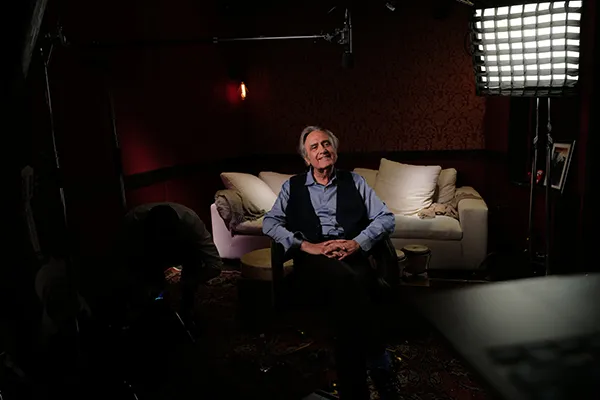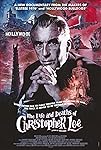Eye For Film >> Movies >> The Life And Deaths Of Christopher Lee (2024) Film Review
The Life And Deaths Of Christopher Lee
Reviewed by: Jennie Kermode

Few people in the history of the world have lived such eventful lives as the late, great Christopher Lee. It would take a lengthy TV series to explore all his stories properly – even the ones he was willing to share – so it’s a bold thing to take them on in a film with a runtime of just 90 minutes. Director Jon Spira does a surprisingly thorough job, and although he isn’t able to go into depth with much of the material, this is a solid start for those interested in exploring further.
Probably the biggest mistake in the film is trying to present it as if it were narrated by Lee himself. There’s ample reason for this conceit: Lee was an impressive and eager narrator (his audiobooks don’t get a mention here but are well worth checking out), and during his lifetime he was often affectionately teased about his perceived pomposity. The difficulty is that his voice was so distinctive, so rich and resonant, that it’s very hard to imitate successfully, and although Peter Serafinowicz makes a bold effort, he doesn’t quite get there. Likewise the puppet used to give him a physical presence, whilst amusing, doesn’t quite capture his look. The result of this, at least for those who know Lee’s work well, is a distracting sense of the uncanny valley which repeatedly interrupts the flow.

Beyond that, the documentary delivers a fairly straightforward biopic, but a witty one, characterised by its title. A cute animated opening credits sequence shows Lee dying repeatedly, as he did in dozens of films – but it’s a while before we get to the films themselves, there being plenty of other adventures to take into account before that. There’s a brief reference to Lee’s descent from Charlemagne, with his niece, actor Harriet Walker, commenting that to keep a title that long one has to have killed a lot of people, and then we drift briefly through his childhood and the events of his youth. That his witnessing of the last ever public guillotining in France – an event which disturbed him greatly – led to him acquiring a collection of execution memorabilia and befriending English hangman Albert Pierrepoint is typical of what follows. Again and again he would become intrigued by the things that challenged him, and somehow he was always at the centre of everything, in touch with all the interesting figures of his time.
Spira does well to maintain the pace as he charts Lee’s military career, considering how much of it remains a secret – being “tall and too foreign-looking” was an advantage to Lee as a spy, despite being a disadvantage to him as an actor, and his career in espionage will become relevant later when the documentary addresses his connections with the James Bond franchise and appearance in The Man With The Golden Gun. As it moves into examining his film career, which takes up the bulk of the running time, Spira makes up for the necessary swift pace by packing in pared-down but delightful anecdotes. We learn for instance, how Lee parried with Errol Flynn and got a permanent finger injury as a result (“Flynn was not a good fencer”), and how his breakthrough role as Frankenstein’s monster was informed by a chat with his friend Boris Karloff. In an aside, we also learn about his courtship of Gitte, whom he he would marry and remain with until his death 54 years later.
There is, of course, a vast amount to cover here, and Spira draws it together well by keeping track of the simple connections that link films, friends and adventures across the decades. Horror fans like those at Frightfest 2024, where the film screened, will particularly enjoy the connections between Lee and fellow horror greats Peter Cushing and Vincent Price, as well as his work with Mario Bava and Jess Franco, but the documentary also looks beyond his horror work at, for instance, his engagement with the works of Arthur Conan Doyle, playing first Sherlock Holmes and later his smarter brother, Mycroft. It addresses his excitement about getting to fight Yoda in Star Wars: Episode 2 - Attack Of The Clones; his pride in winning the praise of the stunt team on Airport ’77; and the longstanding love of The Lord Of The Rings that preceded his turn as Saruman in Peter Jackson’s adaptations.
There is a brief discussion of his performance as Fu Manchu and the difficult issues surrounding that franchise. The documentary skims over his favourite role, as Lord Summerisle in The Wicker Man – there’s plenty to be found on that elsewhere – but spends a little more time on Dracula (including one of the most adorable moments in the franchise – a clip from Scars Of Dracula in which Jenny Hanley is attacked by a cute little rubber bat). It also touches on his personal interest in the occult, and how he persuaded Hammer to take on the work of Dennis Wheatley, leading to To The Devil A Daughter and The Devil Rides Out – yet still finds time to cover the way that his lifelong longing to sing in a film finally came to fruition in The Return Of Captain Invincible.
These stories are expounded upon by a variety of guests, including Joe Dante, John Landis, Peter Jackson and Caroline Munro, and there’s even input from some of the musicians he worked with on his Charlemagne albums, after discovering heavy metal in his nineties. His constant willingness to adapt to new technology was a key factor in his career longevity, and Spira acknowledges this throughout, rather than, like many film fans, trying to fix an iconic performer at one point in time. This open approach makes for a documentary that is, overall, very rewarding, and liable to be an entertaining watch even for complete newcomers.
Reviewed on: 25 Aug 2024
















